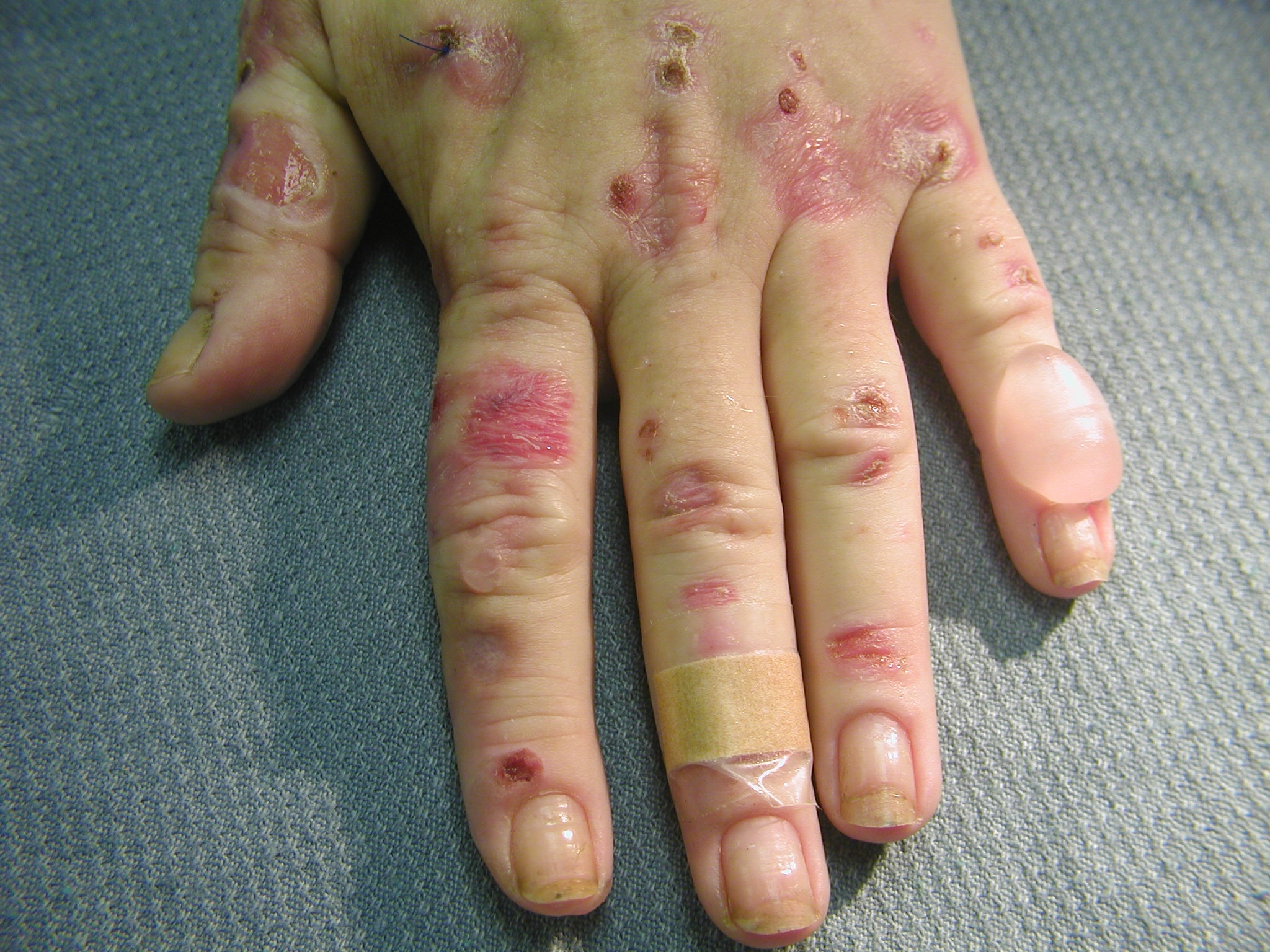User login

A urine sample fluoresced orange-red under a Woods lamp, prompting the FP to suspect porphyria cutanea tarda. A 24-hour urine test for porphyrins confirmed his suspicions.
Porphyria cutanea tarda occurs mostly in middle-aged adults (typically 30-50 years of age) and is rare in children. Risk factors include hepatitis C, oral contraceptive use, and prostate cancer treatment with estrogen therapy. Alcohol, pesticides, and chloroquine have been implicated as chemicals that induce porphyria cutanea tarda; it is equally common in both men and women.
The porphyrias are a family of illnesses caused by various derangements in the metabolism of porphyrin, the chemical backbone of hemoglobin. Whereas the other porphyrias are associated with systemic manifestations, porphyria cutanea tarda has no extracutaneous manifestations. The classic presentation is that of blistering (vesicles and tense bullae) on photosensitive “fragile skin.” As the blisters heal, the skin takes on an atrophic appearance. Hypertrichosis (especially on the cheeks and temples) is also common and may be the presenting feature. Classically the dorsa of the hands are affected.
If the onset is associated with alcohol ingestion, estrogen therapy, or exposure to pesticides, reducing exposure is warranted. Phlebotomy of 500 ml of blood weekly until the hemoglobin is decreased to 10 g is associated with biochemical and clinical remission within a year. Avoidance of excess sunlight exposure (to avoid hypersensitivity) is important. Avoidance of trauma and careful wound care are also necessary.
Text for Photo Rounds Friday courtesy of Richard P. Usatine, MD. Photo courtesy of Lewis Rose, MD. This case was adapted from: Hara, J. Other bullous diseases. In: Usatine R, Smith M, Mayeaux EJ, et al, eds. The Color Atlas of Family Medicine. New York, NY: McGraw-Hill; 2009:799-806.
To learn more about The Color Atlas of Family Medicine, see:
• http://www.amazon.com/Color-Atlas-Family-Medicine/dp/0071474641
The Color Atlas of Family Medicine is also available as an app for mobile devices. See

A urine sample fluoresced orange-red under a Woods lamp, prompting the FP to suspect porphyria cutanea tarda. A 24-hour urine test for porphyrins confirmed his suspicions.
Porphyria cutanea tarda occurs mostly in middle-aged adults (typically 30-50 years of age) and is rare in children. Risk factors include hepatitis C, oral contraceptive use, and prostate cancer treatment with estrogen therapy. Alcohol, pesticides, and chloroquine have been implicated as chemicals that induce porphyria cutanea tarda; it is equally common in both men and women.
The porphyrias are a family of illnesses caused by various derangements in the metabolism of porphyrin, the chemical backbone of hemoglobin. Whereas the other porphyrias are associated with systemic manifestations, porphyria cutanea tarda has no extracutaneous manifestations. The classic presentation is that of blistering (vesicles and tense bullae) on photosensitive “fragile skin.” As the blisters heal, the skin takes on an atrophic appearance. Hypertrichosis (especially on the cheeks and temples) is also common and may be the presenting feature. Classically the dorsa of the hands are affected.
If the onset is associated with alcohol ingestion, estrogen therapy, or exposure to pesticides, reducing exposure is warranted. Phlebotomy of 500 ml of blood weekly until the hemoglobin is decreased to 10 g is associated with biochemical and clinical remission within a year. Avoidance of excess sunlight exposure (to avoid hypersensitivity) is important. Avoidance of trauma and careful wound care are also necessary.
Text for Photo Rounds Friday courtesy of Richard P. Usatine, MD. Photo courtesy of Lewis Rose, MD. This case was adapted from: Hara, J. Other bullous diseases. In: Usatine R, Smith M, Mayeaux EJ, et al, eds. The Color Atlas of Family Medicine. New York, NY: McGraw-Hill; 2009:799-806.
To learn more about The Color Atlas of Family Medicine, see:
• http://www.amazon.com/Color-Atlas-Family-Medicine/dp/0071474641
The Color Atlas of Family Medicine is also available as an app for mobile devices. See

A urine sample fluoresced orange-red under a Woods lamp, prompting the FP to suspect porphyria cutanea tarda. A 24-hour urine test for porphyrins confirmed his suspicions.
Porphyria cutanea tarda occurs mostly in middle-aged adults (typically 30-50 years of age) and is rare in children. Risk factors include hepatitis C, oral contraceptive use, and prostate cancer treatment with estrogen therapy. Alcohol, pesticides, and chloroquine have been implicated as chemicals that induce porphyria cutanea tarda; it is equally common in both men and women.
The porphyrias are a family of illnesses caused by various derangements in the metabolism of porphyrin, the chemical backbone of hemoglobin. Whereas the other porphyrias are associated with systemic manifestations, porphyria cutanea tarda has no extracutaneous manifestations. The classic presentation is that of blistering (vesicles and tense bullae) on photosensitive “fragile skin.” As the blisters heal, the skin takes on an atrophic appearance. Hypertrichosis (especially on the cheeks and temples) is also common and may be the presenting feature. Classically the dorsa of the hands are affected.
If the onset is associated with alcohol ingestion, estrogen therapy, or exposure to pesticides, reducing exposure is warranted. Phlebotomy of 500 ml of blood weekly until the hemoglobin is decreased to 10 g is associated with biochemical and clinical remission within a year. Avoidance of excess sunlight exposure (to avoid hypersensitivity) is important. Avoidance of trauma and careful wound care are also necessary.
Text for Photo Rounds Friday courtesy of Richard P. Usatine, MD. Photo courtesy of Lewis Rose, MD. This case was adapted from: Hara, J. Other bullous diseases. In: Usatine R, Smith M, Mayeaux EJ, et al, eds. The Color Atlas of Family Medicine. New York, NY: McGraw-Hill; 2009:799-806.
To learn more about The Color Atlas of Family Medicine, see:
• http://www.amazon.com/Color-Atlas-Family-Medicine/dp/0071474641
The Color Atlas of Family Medicine is also available as an app for mobile devices. See